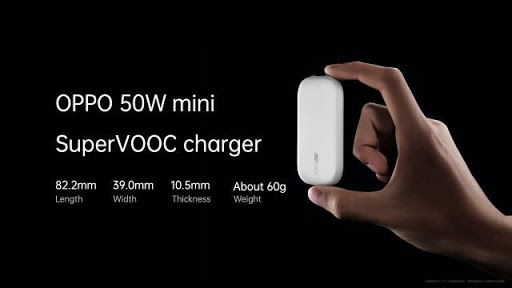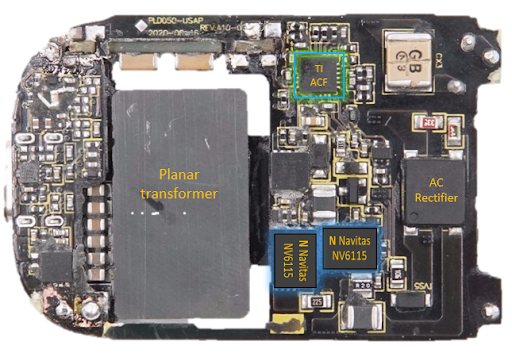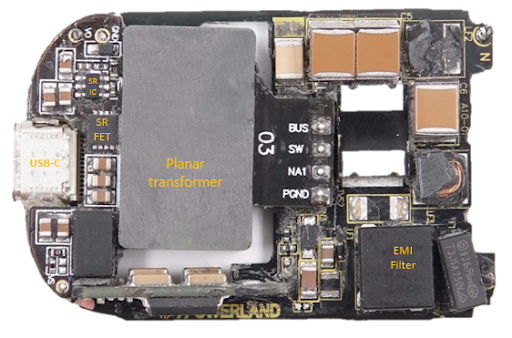OPPO’s “50W Mini SuperVOOC” fast charger, announced on July 15th 2020, uses Navitas’ high-speed GaNFast power ICs to enable a new ‘pulsed’ power conversion topology and achieve the world’s smallest and thinnest form-factor. Measuring only 82.2 x 39.0 x 10.5 mm (34 cc) and only 60 g in weight, the 50W Mini charges 3x faster than competitors in half the size and weight.
With the full 50W available via either OPPO’s own SuperVOOC fast-charging protocol, or the USB-C Programmable Power Supply (PPS) specification, the Mini is a flexible device, capable of charging smartphones, tablets and many laptops. It’s also the same size as the very popular “Wang Wang” rice cookie – hence the nickname!


Let’s look under the hood of this 50W Mini. There are three major technology innovations which enable such a small form-factor:
- Powertrain: Navitas GaNFast power ICs
- Topology: Pulsed Active-Clamp Flyback (pulsed ACF)
- Transformer: High-frequency, low-profile planar
- Powertrain: Navitas GaNFast power ICs
Gallium (Ga, atomic number 31) and nitrogen (N, 7) combine into a semiconductor material – gallium nitride (GaN) – like Silicon (Si, 14). GaN is a ‘wide band-gap’ material because it offers an electron band-gap that is 3x larger than silicon, which means it can can handle large electric fields with dramatically smaller chips. With much smaller transistors and shorter current paths, ultra-low resistance & capacitance is achieved, while enabling up to 100x faster switching speeds. Low resistance and low capacitance translate to higher charging efficiencies, so more of the power is delivered to the battery, charging it faster instead of burning up that energy as heat which warms the charger in your hand. Faster switching means that the charger can deliver more power to the battery with a dramatically smaller size & weight as the energy-storing passive components can shrink dramatically as they store much less energy in each switching cycle.
These speed & energy savings advantages are critical in enabling the OPPO 50W Mini’s amazing power output and small size & lightweight.
To optimize GaN for high speed, high efficiency and high reliability, Navitas created GaNFast power ICs. Here, the GaN power FET is carefully, monolithically integrated with GaN logic and GaN analog circuits on a single GaN chip to form a true GaN power IC. These ‘digital-in power-out’ building blocks – known as GaNFast™ power ICs – deliver robust, high-efficiency performance up to 2 MHz. For the Mini, two NV6115 GaNFast power ICs in speed-optimized, surface-mount QFN packages are used.
- Topology: Pulsed Active-Clamp Flyback (pulsed ACF)
In most chargers, the single-switch ‘flyback’ topology is used at low frequency (~50kHz) to convert power from rectified AC input to the isolated, low-voltage output. In traditional flybacks, a ‘snubber’ system absorbs voltage spikes but this is a point of system energy loss – and creates heat. The OPPO 50W Mini uses a 10x higher-speed, high-efficiency ‘active-clamp’ flyback using TI’s UCC28782 controller with a pair of GaNFast power ICs in a half-bridge configuration. High-speed operation (~400 kHz) is possible due to the ‘soft-switching’ topology and the GaNFast power ICs with extremely low resistance (RDS(ON) to minimize ‘on-state’ losses, and minimal output capacitance (COSS) for the best ‘switching’ performance. High-speed now means that the main isolating transformer, EMI filter, output smoothing capacitors, etc. can shrink in size and cost.
The main elements of the OPPO 50W Mini are shown below:


Images modified from Chongdiantou.
In a traditional charger, a large part of the total size is due to the electrolytic ‘bulk capacitor’ used to smooth out ripple from the rectified AC input prior to the down-converting flyback. The ‘bulk cap’ can occupy 40% of the total charger size. In the 50W Mini design, a proprietary innovation creates the world’s first charger using ‘pulsed’ power conversion. This eliminates the electrolytic bulk capacitor, and the rectified 100Hz pulsating DC feeds directly into the high-frequency ACF circuit which can maintain a smooth output to charge the phone’s battery, even when the input voltage range is wide. This OPPO-proprietary ‘direct-charge’ approach means that during each pulse gap, the polarization effect in the phone battery is eliminated so reducing wear-out mechanisms and extending battery life.
- Transformer: High-frequency, low-profile planar
Traditional transformers operate at a few 10’s of kHz and are constructed using toroidal ferrite cores, with separate wire-windings (primary and secondary) to isolate and convert voltage. As operating frequencies increase, a new flat or ‘planar’ transformer can be created in which the primary and secondary windings are embedded into PCB material – resulting in extremely efficient, high-frequency, low-profile and low-noise (low EMI) systems, while utilizing more automated manufacturing methods for more consistent performance.
Overall, the size difference can be seen comparing a traditional topology with wire-wound transformer (typically over 20 mm) plus large electrolytic bulk capacitor, against the OPPO 50W Mini with new 400 kHz, 8 mm planar transformer and no electrolytic capacitor. The high-speed GaNFast-based Mini is less than half the size of the old, slow, silicon-based version.
Image: OPPO, Navitas
Image: iVankr
The transformer and ‘bulk cap’ are not the only speed-related upgrades. High-frequency operation also shrinks the EMI filters and reduces the output capacitance down to only 100uF, an 80% reduction compared to traditional topologies.
The Next-Generation Revolution:
OPPO’s 50W Mini is a true next-generation GaN fast charger using the latest high-speed topology and enabled by GaNFast Power ICs. It represents the ultimate travel adapter for a huge range of consumers, charging everything from smartphones and tablets, to laptops and beyond. As Jialiang (Jeff) ZHANG, OPPO VOOC Super-Charging Chief Scientist said during the launch: “Using gallium nitride devices to drive transformers to very high frequencies has been the dream of all technical workers for many years”, adding “GaN devices will trigger a technological revolution in the field of power supplies.”

Recent Comments